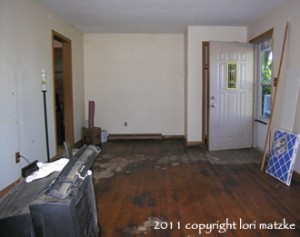Learn – HOW TO PAINT WOOD FLOORS

After removing the carpeting, we found the wood floors beneath solid and sturdy, but stained beyond repair.
Painted wood floors use to be quite stylish in the 17th and 18th centuries and eventually fell out of favor when carpeting became all the rage. But painting can be a wonderful, low-cost alternative to replacing wood floors that are beyond repair. And they can be just plain beautiful as your first choice! Renown interior designer Albert Hadley famously paints wood floors in his signature shade of deep green.
In this home, while the owner originally bought the home intending to simply have the wood floors beneath the carpeting redone, it became clear wood grain floors were not in his future when even professionals could not remove the many deeply set pet stains from the wood. Painting became the alternative solution, but the end result gave it first choice appeal!
Please note: For this project, a water-based paint and polyurethane were used. Unlike oil based paints and polys, water-based alternatives will not yellow.
- Sand the floors! If the floors are in fairly good condition, a light sanding using 150-grade paper by hand or using a hand sander is all that is required. You are simply sanding so the floors will accept the paint. However, if the varnish is peeling and/or bubbling, I recommend using a professional sander to smooth out the surface and completely remove the varnish. (You can rent a professional sander from most home improvement stores, usually by the hour.)
- Wash using a powder detergent to remove all dust and particles. This may take more than a day to dry completely but it’s important to give it time.
- Apply one coat of primer to prepare the wood and prevent the stain color from bleeding through. The primer should be allowed to dry overnight. (In this case, Zinsser Bin Primer was used.)
- Lightly sand using 220-grade sandpaper, then wipe the floor clean using tack cloth to remove all the dust particles.

The painted wood floors offered an inviting and inexpensive alternative to carpeting or laminate.
- Apply one thin coat of Benjamin Moore Low-Lustre Metal & Wood Enamel paint, as thin coats tend to dry harder than thicker coats. Use a paint brush with natural bristles to apply, as rolling it on may leave stippling marks. Allow paint to dry 24 hours.
- Apply two more thin coats of paint, allowing 24 hours drying time between coats.
- Apply two thin coats of Benjamin Moore Low-Lustre Acrylic Polyurethane allowing 24 hours to dry between coats. (Low-Lustre offers a very nice sheen. High-Gloss could also be used, but will be more inclined to show nicks and scratches over time.)
- Painted flooring takes about 30 days to completely cure. Use caution when moving furniture and remove shoes at the door to prevent scratches and scuff marks until the paint and poly has had a chance to set.




